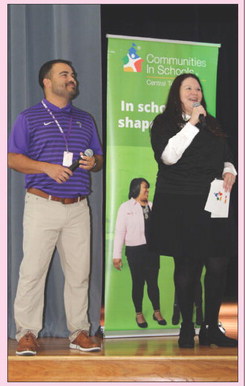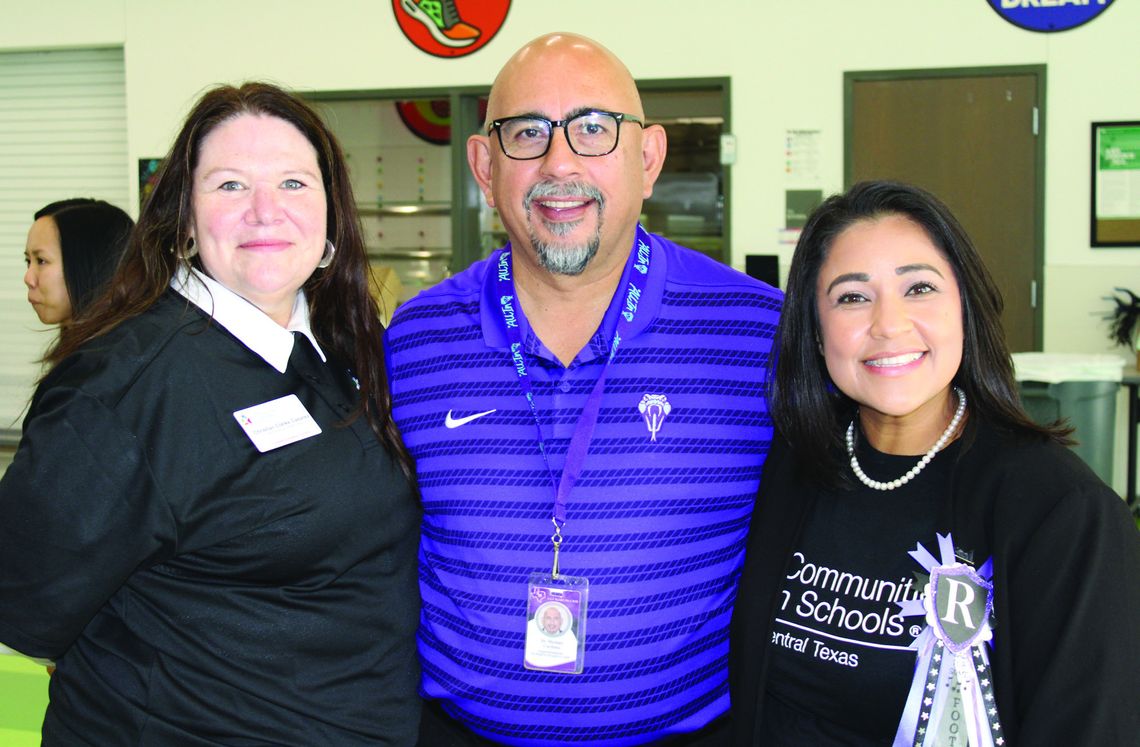SAN MARCOS CISD
Communities in Schools helps students get the resources needed to succeed
To learn in school, students have to be present – both physically and mentally – but there are a variety of factors that can hinder a student’s ability to make it to class or participate when they are present. San Marcos Consolidated Independent School District has partnered with Communities in Schools for a holistic approach to education. According to the website, Communities in Schools is a nationwide organization that collaborates with parents, educators, community-based organizations and school and district leaders to help students overcome obstacles and succeed in school and life.
“There are many reasons that prevent students from regularly attending school ranging from transportation, mental or physical health, access to clean clothes or food insecurity,” the CIS website stated. “CIS site coordinators are physically present inside schools, working hand-inhand with administrators and families to provide essential resources for student success.”
Communities in Schools recently held a panel discussion at Rodriguez Elementary to discuss how the program helps local students. The discussion was moderated by Christian Clarke Casarez, CIS of Central Texas chief advocacy and outreach officer, and featured Michael Cardona, SMCISD superintendent; Sharon Vigil, CIS of Central Texas chief executive officer; and Adriana Guerrero, SMCISD social emotional learning and guidance director.
Cardona said he was formerly employed at Houston ISD where he saw great results with CIS using a “whole child, whole family” approach. At SMSHANNON CISD there were seven suicides that occurred at the secondary schools, one of which made national news.

Communities in Schools has partnered with SMCISD to ensure that all students are able to be present and mentally and physically capable to attend class. Above, Christian Clarke Casarez, CIS of Central Texas chief advocacy and outreach officer, Michael Cardona, SMCISD superintendent, and Sharon Vigil, CIS of Central Texas chief executive officer. Below, Andrew Fernandez, SMCISD communications chief, and Christian Clarke Casarez, CIS of Central Texas chief advocacy and outreach officer. Daily Record photos by Shannon West
“We began with social emotional counselors at the high school … We did everything right. A teacher identified an issue. A teacher went to report it to a counselor. A counselor reported to an administrator. We called the parent. The parent had the kid in counseling. The parents were trying to get the kid in crisis counseling when something tragic happened. So we already knew that we had a system that was supposed to work the right way but didn’t,” Cardona said. “So when Lucio [Calzada, CIS board chair,] called I was like, ‘Ok, we’re going to take a little bit more aggressive approach.’” Cardona said CIS is now at 100% of SMCISD campuses.
“The big players are the principals,” Cardona said. “They took it on, and they help us grow it and develop it every year.”
Vigil said CIS’s holistic approach involves three tiers.
“The first tier is what we call tier one services, and that is a holistic approach where we case manage the entire campus. And it always starts off with goals. It always starts off with data, looking at what is happening for the principal? What is happening with their campus improvement plan? What is happening with the community? So we spend a lot of time listening to the community every single year before we set our goals,” Vigil said. “Tier one services also includes, you talked about our food pantry, you talked about a micro grant. So our program managers are able to apply for additional funding if they want to do a special project on a campus, and we fundraise for that additional funding.”
The remaining tiers address the students whose needs go beyond tier one.
“But then there is another group of students who need just a little bit more, and it might look different from year to year for that student. When that student has lost a family member, CIS is there to provide grief and loss support for them. When the student is dealing with anxiety or they’re not able to self regulate, we conduct processing groups with them so that they’re able to reflect,” Vigil said. “Then we have the final tier, and these are students who maybe are chronically absent. They are not showing up. These are students who maybe are homeless. These are students who are moving a lot. It also might just mean students who are trying to figure out how to function in a space with hundreds of people in it. And then we’re able to provide one on one services to them. And really, it’s when we’re calling them, chatting with them, two to three times a week.”
The financial burden of CIS does not fall solely on the school district.
“A lot of school districts do ask for CIS because, not only… [do we have] a research-based, national model that has had multiple third-party research[ers that studied the program] in the past 30 years, but we’re also a good deal,” Vigil said. “A school district does not pay holistically for CIS. We cost share. A school district pays about 30 to 35%, and then we go out and fundraise all the rest. And we do that because we also believe that schools don’t have to do it alone. They need transformative partners to do this work.”
Cardona said as the superintendent of a D-rated school district, his second concern is still academics.
“That’s for the board to worry about when they evaluate me. My concern is the kid and figuring this out together to get the kid in school, to get them literate, to get them numerate, to get them to [the point that]… when the kid walks the stage, they can make their own decisions. And [to get them to where] we know when they walk, they’re going to be successful without remediation, not only academically, career wise [and] military wise, but mental health wise,” Cardona said. “You’re starting to see the effects of this approach. We increased the number of graduates. This past year… [was] our largest graduating class since I’ve been here.”
Learn more about CIS at this link communitiesinschools. org.








